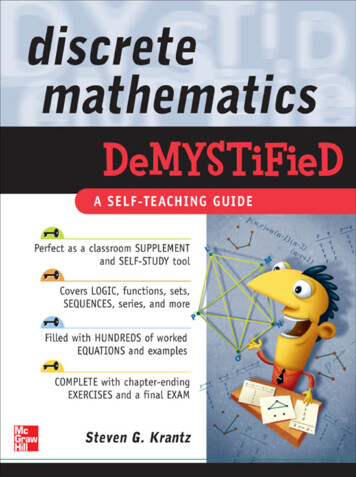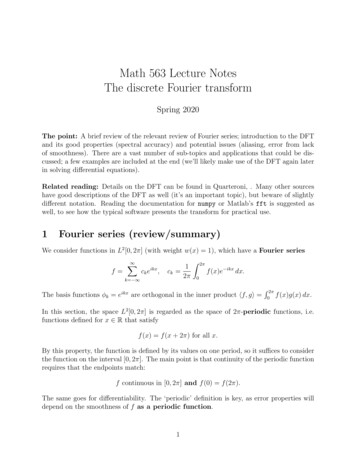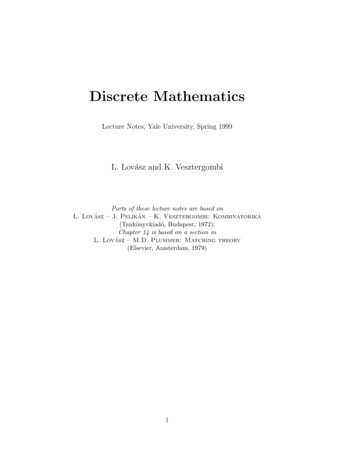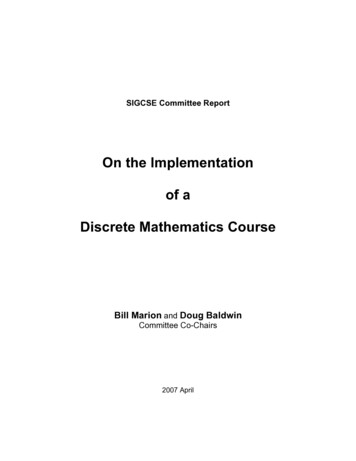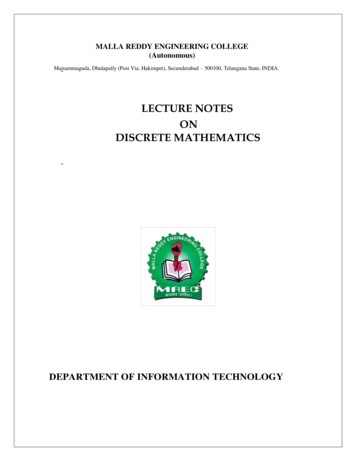
Transcription
MALLA REDDY ENGINEERING COLLEGE(Autonomous)Maisammaguda, Dhulapally (Post Via. Hakimpet), Secunderabad – 500100, Telangana State, INDIA.LECTURE NOTESONDISCRETE MATHEMATICSDEPARTMENT OF INFORMATION TECHNOLOGY
Prerequisites: NILCourse Objectives: This course provides the concepts of mathematical logic demonstrate predicate logic and Binary Relations among different variables, discuss different type of functions and concepts of Algebraic system and its properties. It also evaluates techniques of Combinatorics based on counting methods and analyzes the concepts of Generating functions to solve Recurrence equations.MODULE I: Mathematical LogicBasic Logics - Statements and notations, Connectives, Well-formed formulas, Truth Tables,tautology. Implications and Quantifiers - Equivalence implication, Normal forms, Quantifiers,Universal quantifiers.MODULE II: Predicate Logic and RelationsPredicate Logic - Free & Bound variables, Rules of inference, Consistency, proof ofcontradiction, Proof of automatic Theorem. Relations - Properties of Binary Relations,equivalence, transitive closure, compatibility and partial ordering relations, Lattices, Hassediagram.MODULE III: Functions and Algebraic Structures[10 Periods]A: Functions - Inverse Function, Composition of functions, recursive Functions – Lattice and itsProperties.B: Algebraic structures - Algebraic systems Examples and general properties, Semigroups andmonoids, groups, sub-groups, homomorphism, Isomorphism, Lattice as POSET, Booleanalgebra.MODULE IV: Counting Techniques and Theorems[09 Periods]Counting Techniques - Basis of counting, Combinations and Permutations with repetitions,Constrained repetitions Counting Theorems - Binomial Coefficients, Binomial and Multinomialtheorems, principles of Inclusion – Exclusion. Pigeon hole principle and its applications.MODULE V: Generating functions and Recurrence Relation[09 Periods]Generating Functions - Generating Functions, Function of Sequences, Calculating Coefficient ofgenerating function. Recurrence Relations - Recurrence relations, Solving recurrence relation bysubstitution and Generating functions. Method of Characteristics roots, solution of Nonhomogeneous Recurrence Relations.TEXTBOOKS1. J P Tremblay & R Manohar, “Discrete Mathematics with applications to Computer Science”,Tata McGraw Hill.2. J.L. Mott, A. Kandel, T.P.Baker “Discrete Mathematics for Computer Scientists &Mathematicians”, PHI. REFERENCES1. Kenneth H. Rosen, "Discrete Mathematics and its Applications”, TMH, Fifth Edition.2. Thomas Koshy, "Discrete Mathematics with Applications", Elsevier.3. Grass Man & Trembley, "Logic and Discrete Mathematics”, Pearson Education.4. C L Liu, D P Nohapatra, “Elements of Discrete Mathematics - A Computer OrientedApproach”, Tata McGraw Hill, Third Edition.E-RESOURCES1. http://www.cse.iitd.ernet.in/ bagchi/courses/discrete-book/fullbook.pdf2. http://www.medellin.unal.edu.co/ curmat/matdiscretas/doc/Epp.pdf
3. QLYsrFyeITA70W9C8Pg4. http://nptel.ac.in/courses/106106094/Course Outcomes:At the end of the course, a student will be able to1. Apply the concepts of connectives and normal forms in real time applications.2. Summarize predicate logic, relations and their operations.3. Describe functions, algebraic systems, groups and Boolean algebra.4. Illustrate practical applications of basic counting principles, permutations, combinations, andthe pigeonhole nsandrecurrencerelations.
MODULE-IMathematical LogicStatements and notations:A proposition or statement is a declarative sentence that is either true or false (but not both). Forinstance, the following are propositions: Paris is in France (true) London is in Denmark (false) 2 4 (true) 4 7 (false)However the following are not propositions: what is your name? (this is a question) do your homework (this is a command) this sentence is false (neither true nor false) x is an even number (it depends on what x represents) Socrates (it is not even asentence)The truth or falsehood of a proposition is called its truth value. Connectives:Connectives are used for making compound propositions. Generally used five connectives are – OR (V) AND (K) Negation/ NOT ( ) Implication / if-then ( ) If and only if ( ).Well formed formulas (wff):The strings that produce a proposition when their symbols are interpreted must follow the rulesgiven below, and they are called wffs(well-formed formulas) of the first order predicate logic.DM1
A predicate name followed by a list of variables such as P(x, y), where P ispredicate name, and x and y are variables, is called an atomic formula.A well formed formula of predicate calculus is obtained by using the following rules.1. An atomic formula is a wff.2. If A is a wff, then A is also a wff.3. If A and B are wffs, then (A V B), (A ٨ B), (A B) and (A B) are wffs.4. If A is a wff and x is any variable, then (x)A and ( x)A are wffs.5. Only those formulas obtained by using (1) to (4) are wffs.Wffs are constructed using the following rules:1. True and False are wffs.2. Each propositional constant (i.e. specific proposition), and each propositionalvariable (i.e. a variable representing propositions) are wffs.3. Each atomic formula (i.e. a specific predicate with variables) is a wff.4. If A, B, and C are wffs, then so areA, (AB), (AB), (AB), and (AB).5. If x is a variable (representing objects of the universe of discourse), and A is awff, then so are x A and x A .For example, "The capital of Virginia is Richmond." is a specific proposition. Hence it isa wff by Rule 2.Let B be a predicate name representing "being blue" and let x be a variable. Then B(x) isan atomic formula meaning "x is blue". Thus it is a wff by Rule 3. above.By applying Rule 5. to B(x),xB(x) is a wff and so isxB(x).Then by applying Rule 4. to them x B(x)x B(x) is seen to be a wff. Similarly if Ris a predicate name representing "being round". Then R(x) is an atomic formula. Hence itis a wff.By applying Rule 4 to B(x) and R(x), a wff B(x)R(x) is obtained.To express the fact that Tom is taller than John, we can use the atomic formulataller(Tom, John), which is a wff. This wff can also be part of some compound statementsuch as taller(Tom, John) taller(John, Tom), which is also a wff. If x is a variablerepresenting people in the world, then taller(x,Tom), x taller(x,Tom), xtaller(x,Tom), x y taller(x,y) are all wffs among others. However, taller( x,John)and taller(Tom Mary, Jim), for example, are NOT wffs.DM2
Truth Tables:Logical identityLogical identity is an operation on one logical value, typically the value of aproposition that produces a value of true if its operand is true and a value of false ifits operand is false.The truth table for the logical identity operator is as follows:Logical IdentityppTTFFLogical negationLogical negation is an operation on one logical value, typically the value of aproposition that produces a value of true if its operand is false and a value of falseif its operand is true.The truth table for NOT p (also written as p or p) is as follows:Logical Negationp pTFFTLogical conjunction:Logical conjunction is an operation on two logical values, typically the values of twopropositions, that produces a value of true if both of its operands are true.The truth table for p AND q (also written as p K q, p & q, or p q) is as follows:If both p and q are true, then the conjunction p K q is true. For all other assignmentsof logical values to p and to q the conjunction p K q is false. It can also be said thatif p, then p K q is q, otherwise p K q is p.DM3
Logical ConjunctionPqpKqTTTTFFFTFFFFLogical disjunction:Logical disjunction is an operation on two logical values, typically the values of twopropositions, that produces a value of true if at least one of its operands is true.The truthtable for p OR q (also written as p V q, p q, or p q) is as follows:Logical DisjunctionpqpVqTTTTFTFTTFFFLogical implication:Logical implication and the material conditional are both associated with an operation ontwo logical values, typically the values of two propositions, that produces a value of falsejust in the singular case the first operand is true and the second operand is false.Logical ImplicationDMpqp qTTTTFFFTT4
FFTThe truth table associated with the material conditional if p then q (symbolized as p q)and the logical implication p implies q (symbolized as p ‹ q) is as shown above.Logical equality:Logical equality (also known as biconditional) is an operation on two logical values,typically the values of two propositions, that produces a value of true if both operands arefalse or both operands are true.The truth table for p XNOR q (also written as p q ,p q, or p q) is as follows:Logical Equalitypqp qTTTTFFFTFFFTExclusive disjunction:Exclusive disjunction is an operation on two logical values, typically the values oftwo propositions, that produces a value of true if one but not both of its operands istrue.The truth table for p XOR q (also written as p q, or p q) is as follows:pExclusive Disjunctionqp qTTFTFTFTTFFFLogical NAND:The logical NAND is an operation on two logical values, typically the values of twopropositions, that produces a value of false if both of its operands are true. In other words,it produces a value of true if at least one of its operands is false.The truth table for pNAND q (also written as p q or p q) is as follows:DM5
\Logical NANDPqp qTTFTFTFTTFFTIn the case of logical NAND, it is clearly expressible as a compound of NOT and AND.The negation of a conjunction: (p K q), and the disjunction of negations: ( p) V ( q) issame.Logical NORThe logical NOR is an operation on two logical values, typically the values of twopropositions, that produces a value of true if both of its operands are false. In other words, itproduces a value of false if at least one of its operands is true. is also known as the Peircearrow after its inventor, Charles Sanders Peirce, and is a Sole sufficient operator.The truth table for p NOR q (also written as p q or p T q) is as follows:Logical NORpqp qTTFTFFFTFFFTThe negation of a disjunction (p V q), and the conjunction of negations ( p) K ( q) is same.Inspection of the tabular derivations for NAND and NOR, under each assignment oflogical values to the functional arguments p and q, produces the identical patterns offunctional values for (p K q) as for ( p) V ( q), and for (p V q) as for ( p) K ( q). ThusDM6
the first and second expressions in each pair are logically equivalent, and may besubstituted for each other in all contexts that pertain solely to their logical values.This equivalence is one of De Morgan's laws.The truth value of a compound proposition depends only on the value of its components.F for false and T for true summarizes the meaning of the connectives in following way:p pqpK qp qpV qp qp qTTFTTFTTTFFFTTFFFTTFTTTFFFTFFFTTNote that V represents a non-exclusive or, i.e., p V q is true when any ofp, q is true andalso when both are true. On the other hand represents an exclusive or, i.e., p q sitrue only when exactly one of p and q is true.Tautology, Contradiction, Contingency:A proposition is said to be a tautology if its truth value is T for any assignment of truthvalues to its components. Example: The proposition p V p is a tautology.A proposition is said to be a contradiction if its truth value is F for any assignment oftruth values to its components. Example: The proposition p K p is a contradiction.A proposition that is neither a tautology nor a contradiction is called a contingency.p pTFTFFTFTEquivalence Implication:p V pp K pTTTTFFFFWe say that the statements r and s are logically equivalent if their truth tables areidentical.DM7
For example the truth table is:-showsis equivalent to. It is easily shown that the statements rand s are equivalent if and only if is a tautology.Normal forms:Let A(P1, P2, P3, , Pn) be a statement formula where P1, P2, P3, , Pn are the atomicvariables. If A has truth value T for all possible assignments of the truth values to thevariables P1, P2, P3, , Pn , then A is said to be a tautology. If A has truth value F, thenA is said to be identically false or a contradiction.Disjunctive Normal FormsA product of the variables and their negations in a formula is called an elementaryproduct. A sum of the variables and their negations is called an elementary sum. That is, asum of elementary products is called a disjunctive normal form of the given formula.Example:(1)(2)(3)(4)(5)Principal Disjunctive Normal Form (PDNF)Let us assume Aand B be two statement variables. All possible formulas by s uing conjunction aregiven as follows. The total number of formulas for two variables A and B are 22 formulas. They areA ÙB , A Ù ùB,ùA Ù B and ù AÙ ù B.These are calledm interms or Boolean con junctions of A and B. The minterms (2n terms) aredenoted by M0,M 1, ,M2n-1.A formula equivalent to a given formulaconsisting of the disjunction of minterms only iscalled PDNF of the given formula.DM8
Conjunctive Normal FormsA formula which is equivalent to a given formula and which consists of aproduct of elementary sums is called a conjunctive normal form of a givenformula.Example:(1)(2)(3)(4)Principal Conjunctive Normal Forms (PCNF)The duals of minterms are called maxterms. For a given number of variables the maxterm consists ofdisjunctions in which each variable or its negation, but not both, appears only once.For a given formula, an equivalent formula consisting of conjunctions of maxterms only is known as itsprincipal conjunctive normal form. This is also called the product of sums canonical form.QUANTIFIERSThe variable of predicates is quantified by quantifiers. There are two types of quantifier in predicatelogic Universal Quantifier and Existential Quantifier.Universal QuantifierUniversal quantifier states that the statements within its scope are true for every value of the specificvariable. It is denoted by the symbol 6.6x P(x) is read as for every value of x, P(x) is true.Example "Man is mortal" can be transformed into the propositional form 6x P(x) where P(x) is thepredicate which denotes x is mortal and the universe of discourse is all men.Existential QuantifierExistential quantifier states that the statements within its scope are true for some values of the specificvariable. It is denoted by the symbol E.Ex P(x) is read as for some values of x, P(x) is true.DM9
Example "Some people are dishonest" can be transformed into the propositional form Ex P(x)where P(x) is the predicate which denotes x is dishonest and the universe of discourse is some people.Nested QuantifiersIf we use a quantifier that appears within the scope of another quantifier, it is called nested quantifier.Example 6a Eb P (x, y) where P (a, b) denotes a b 0 6a 6b 6c P (a, b, c) where P (a, b) denotes a (b c) (a b) cNote 6a Eb P (x, y) Ea 6b P (x, y)PredicatesPredicative logic:A predicate or propositional function is a statement containing variables. For instance ―x 2 7 , ―X is American , ―x y , ―p is a prime number are predicates. The truthvalue of hetpredicate depends on the value assigned to its variables. For instance if we replacex with 1 in the predicate ―x 2 7 we obtain ―1 2 7 , which is false, but if we replaceit with 5 we get ―5 2 7 , which is true.We represent a predicate by a letter followed by the variables enclosed between parenthesis:P (x), Q(x, y), etc. An example for P (x) is a value of x for which P (x) is true. Acounterexample is a value of x for which P (x) is false. So, 5 is an example for ―x 2 7 ,while 1 is a counterexample.Each variable in a predicate is assumed to belong to a universe(or domain) of discourse, forinstance in the predicate ―n is an odd integer ’n’ represents an integer, so the universe ofdiscourse of n is the set of all integers. In ―X is American we may assume that X is ahuman being, so in this case the universe of discourse is the set of all human beings.Free & Bound variables:Have a look at the following formula:The first occurrence of x is free, whereas the second and third occurrences of x are bound, namely bythe first occurrence of the quantifier . The first and second occurrences of the variable y are alsoDM10
bound, namely by the second occurrence of the quantifier .Informally, the concept of a bound variable can be explained as follows: Recall that quantificationsare generally of the form:orwhere may be any variable. Generally, all occurences of this variable within the quantification arebound. But we have to distinguish two cases. Look at the following formula to see why:1.may occur within another, embedded, quantificationor , such as the inin ourexample. Then we say that it is bound by the quantifier of this embedded quantification (and so on, ifthere's another embedded quantification over within ).2. Otherwise, we say that it is bound by the top-level quantifier (like all other occurences of in ourexample).Here's a full formal simultaneous definition of free and bound:1. Any occurrence of any variable is free in any atomic formula.2. No occurrence of any variable is bound in any atomic formula.3. If an occurrence of any variable is free in or in , then that same occurrence is free in,,, and.4. If an occurrence of any variable is bound in or in , then that same occurrence is bound in,,,. Moreover, that same occurrence is bound inandas well, for anychoice of variable y.5. In any formula of the formor(where y can be any variable at all in this case) the occurrenceof y that immediately follows the initial quantifier symbol is bound.6. If an occurrence of a variable x is free in , then that same occurrence is free inand, for anyvariable y distinct from x. On the other hand, all occurrences of x that are free in , are bound inand in.If a formula contains no occurrences of free variables we call it a sentence .Rules of inference:The two rules of inference are called rules P and T.Rule P: A premise may be introduced at any point in the derivation.DM11
Rule T: A formula S may be introduced in a derivation if s is tautologically implied byany one or more of the preceding formulas in the derivation.Before proceeding the actual process of derivation, some important list of implications andequivalences are given in the following tables:ImplicationsI1 P٨Q PI2 PQ٨ QI3 P PVQI4 Q PVQI5 7P P QI6 Q P QI7 7(P Q) PI8 7(P Q) QI9 P, Q P ٨ QI10 7P, PVQ Qsyllogism)I11 P, P Q QI12 7Q, P Q 7P} Simplification} Addition( disjunctive( modus ponens )(modus tollens )I13 P Q, Q R P Rsyllogism)( hypotheticalI14 P V Q, P Q, Q R R (dilemma)EquivalencesE1 77P PE2 P ٨ Q Q ٨ P} Commutative lawsE3 P V Q Q V PE4 (P ٨ Q) ٨ R P ٨ (Q ٨ R)} Associative lawsE5 (P V Q) V R PV (Q V R)E6 P ٨ (Q V R) (P ٨ Q) V (P ٨ R) }DistributivelawsE7 PV (Q ٨ R) (P V Q) ٨ (PVR)E8 7(P ٨ Q) 7P V7QE9 7(P V Q) 7P ٨ 7QDM}De Morgan’s laws12
E10 P V P PE11 P ٨ P PExample 1.Show that R is logically derived from P Q, Q R, and PSolution.{1}(1) P QRule P{2}(2) PRule P{1, 2}(3) QRule (1), (2) and I11{4}(4) Q RRule P{1, 2, 4}(5) RRule (3), (4) and I11.Example 2.Show that S V R tautologically implied by ( P V Q) ٨ ( P R) ٨ ( Q S ).Solution .{1}(1)PVQRule P{1}(2) 7P Q{3}(3) Q S{1, 3}(4) 7P ST, (2), (3), and I13{1, 3}(5) 7S PT, (4), E13 and E1{6}(6){1, 3, 6}(7) 7S RT, (5), (6), and I13{1, 3, 6)(8)T, (7), E16 and E1T, (1), E1 and E16PP RPSVRExample 3. Show that 7Q, P Q 7PSolution .{1}(1) P QRule P{1}{3}(2) 7P 7Q(3) 7QT, and E 18P{1, 3}(4) 7PT, (2), (3), and I11 .Example 4 .Prove that R ٨ ( P V Q ) is a valid conclusion from thepremises PVQ , Q R, P M and 7M.Solution .DM{1}(1) P MP13
{2}(2) 7MP{1, 2}(3) 7PT, (1), (2), and I12{4}(4) P V QP{1, 2 , 4}(5) QT, (3), (4), and I10.{6}(6) Q RP{1, 2, 4, 6}(7) RT, (5), (6) and I11{1, 2, 4, 6}(8) R ٨ (PVQ)T, (4), (7), and I9.There is a third inference rule, known as rule CP or rule of conditional proof.Rule CP: If we can derives s from R and a set of premises , then we can derive R S from the set of premises alone.Note. 1. Rule CP follows from the equivalence E10 whichstates that ( P ٨ R ) S óP (R S).2. Let P denote the conjunction of the set of premises and let R be anyformula The above equivalence states that if R is included as anadditional premise andS is derived from P ٨ R then R S can be derived from the premises P alone.3. Rule CP is also called the deduction theorem and is generallyused if the conclusion is of the form R S. In such cases, Ris taken as an additional premise and S is derived from thegiven premises and R.Example 5 .Show that R S can be derived from thepremises P (Q S), 7R V P , and Q.Solution.DM{1}(1) 7R V PP{2}(2) RP, assumed premise{1, 2}(3)PT, (1), (2), and I10{4}(4)P (Q S){1, 2, 4}(5)Q S{6}(6) Q{1, 2, 4, 6}(7) S{1, 4, 6}(8)R SPT, (3), (4), and I11PT, (5), (6), and I11CP.14
Example 6.Show that P S can be derived from the premises,7P V Q, 7Q V R, and R S .Solution.{1}(1) 7P V QP{2}(2) PP, assumed premise{1, 2}(3) QT, (1), (2) and I11{4}(4) 7Q V RP{1, 2, 4}(5) RT, (3), (4) and I11{6}(6) R SP{1, 2, 4, 6}(7) ST, (5), (6) and I11{2, 7}(8) P SCPExample 7. If there was a ball game , then traveling was difficult. If they arrived ontime, then traveling was not difficult. They arrived on time. Therefore, there was no ballgame . Show that these statements constitute a valid argument.Solution. Let P: There was a ball gameQ: Traveling wasdifficult. R: Theyarrived on time.Given premises are: P Q, R 7Q and R conclusion is: 7PDM{1}(1) P QP{2}(2) R 7QP{3}(3) RP{2, 3}(4) 7QT, (2), (3), and I11{1, 2, 3}(5) 7PT, (2), (4) and I1215
Consistency of premises:ConsistencyA set of formulas H1, H2, , Hm is said to be consistent if their conjunction hasthe truth value T for some assignment of the truth values to be atomic appearingin H1, H2, , Hm.InconsistencyIf for every assignment of the truth values to the atomic variables, at least one of theformulas H1, H2, Hm is false, so that their conjunction is identically false, then theformulasH1, H2, , Hm are called inconsistent.A set of formulas H1, H2, , Hm is inconsistent, if their conjunctionimplies a contradiction, that is H1٨ H2٨ ٨ Hm R ٨ 7RWhere R is any formula. Note that R ٨ 7R is a contradiction and it is necessaryand sufficient that H1, H2, ,Hm are inconsistent the formula.Indirect method of proofIn order to show that a conclusion C follows logically from the premises H1,H2, , Hm, we assume that C is false and consider 7C as an additional premise. If thenew set of premises is inconsistent, so that they imply a contradiction, then theassumption that 7C is true does not hold simultaneously with H1٨ H2٨ . ٨ Hm beingtrue. Therefore, C is true whenever H1٨ H2٨. ٨ Hm is true. Thus, C follows logically from the premises H1, H2 ., Hm.Example 8 Show that 7(P ٨ Q) follows from 7P٨ 7Q.Solution.We introduce 77 (P٨ Q) as an additional premise and show that this additional premiseleads to a contradiction.{1}(1)77(P٨ Q)P assumed premise{1}(2)P٨ QT, (1) and E1{1}(3)PT, (2) and I1{1}{4) 7P٨7Q{4}(5)7PT, (4) and I1{1, 4}(6)P٨ 7PT, (3), (5) and I9PHere (6) P٨ 7P is a contradiction. Thus {1, 4} viz. 77(P٨ Q) andDM16
7P٨ 7Q leads to a contradiction P ٨ 7P.Example 9Show that the following premises are inconsistent.1.If Jack misses many classes through illness, then he fails high school.2.If Jack fails high school, then he is uneducated.3.If Jack reads a lot of books, then he is not uneducated.4.Jack misses many classes through illness and reads a lot of books.Solution.P: Jack missesmany classes. Q:Jack fails highschool.R: Jack reads a lotof books. S: Jack isuneducated.The premises are P Q, Q S, R 7S and P٨ R{1}(1) P QP{2}(2) Q SP{1, 2}(3) P ST, (1), (2) and I13{4}(4) R 7SP{4}(5) S 7RT, (4), and E18{1, 2, 4}(6) P 7RT, (3), (5) and I13{1, 2, 4}(7)7PV7RT, (6) and E16{1, 2, 4}(8)7(P٨R)T, (7) and E8{9}(9)P٨ R{1, 2, 4, 9) (10) (P٨ R) ٨ 7(P٨ R)DMPT, (8), (9) and I917
The rules above can be summed up in the following table. The "Tautology"column shows how to interpret the notation of a given rule.Rule of ctionModus ponensModus tollensHyp othetical syllogismDisjunctive syllogismR esolutionDM18
Example 1Let us consider the following assumptions: "If it rains today, then we will not go on a canoetoday. If we do not go on a canoe trip today, then we will go on a canoe trip tomorrow. Therefore(Mathematical symbol for "therefore" is ), if it rains today, we will go on a canoe triptomorrow. To make use of the rules of inference in the above table we let p be the proposition "Ifit rains today", q be " We will not go on a canoe today" and let r be "We will go on a canoe triptomorrow". Then this argument is of the form:Example 2Let us consider a more complex set of assumptions: "It is not sunny today and it is colder thanyesterday". "We will go swimming only if it is sunny", "If we do not go swimming, then we willhave a barbecue", and "If we will have a barbecue, then we will be home by sunset" lead to theconclusion "We will be home before sunset." Proof by rules of inference: Let p be theproposition "It is sunny this today", q the proposition "It is colder than yesterday", r theproposition "We will go swimming", s the proposition "We will have a barbecue", and t theproposition "We will be home by sunset". Then the hypotheses becomeand. Using our intuition we conjecture that the conclusionmight be t. Using the Rules of Inference table we can proof the conjecture easily:Step1.Hypothesis2.Simplification using Step 13.Hypothesis4.Modus tollens using Step 2 and35.Hypothesis6.7.DMReasonsModus ponens using Step 4 and5Hypothesis19
8. tModus ponens using Step 6 and7Proof of contradiction:The "Proof by Contradiction" is also known as reductio ad absurdum, which is probablyLatin for "reduce it to something absurd".Here's the idea:1. Assume that a given proposition is untrue.2. Based on that assumption reach two conclusions that contradict each other.This is based on a classical formal logic construction known as Modus Tollens: If P implies Qand Q is false, then P is false. In this case, Q is a proposition of the form (R and not R) which isalways false. P is the negation of the fact that we are trying to prove and if the negation is nottrue then the original proposition must have been true. If computers are not "not stupid" thenthey are stupid. (I hear that "stupid computer!" phrase a lot around here.)Example:Lets prove that there is no largest prime number (this is the idea of Euclid's originalproof). Prime numbers are integers with no exact integer divisors except 1 andthemselves.1. To prove: "There is no largest prime number" by contradiction.2. Assume: There is a largest prime number, call it p.3. Consider the number N that is one larger than the product of all of the primes smallerthan or equal to p. N 1*2*3*5*7*11.*p 1. Is it prime?4. N is at least as big as p 1 and so is larger than p and so, by Step 2, cannot be prime.5. On the other hand, N has no prime factors between 1 and p because they would all leavea remainder of 1. It has no prime factors larger than p because Step 2 says that there are noprimes larger than p. So N has no prime factors and therefore must itself be prime (see notebelow).We have reached a contradiction (N is not prime by Step 4, and N is prime by Step 5) andtherefore our original assumption that there is a largest prime must be false.Note: The conclusion in Step 5 makes implicit use of one other important theorem: TheFundamental Theorem of Arithmetic: Every integer can be uniquely represented as the productof primes. So if N had a composite (i.e. non-prime) factor, that factor would itself have primefactors which would also be factors of N.DM20
Automatic Theorem Proving:Automatic Theorem Proving (ATP) deals with the development of computer programs that showthat some statement (the conjecture) is a logical consequence of a set of statements (the axiomsand hypotheses). ATP systems are used in a wide variety of domains.The language in which the conjecture, hypotheses, and axioms (generically known as formulae)are written is a logic, often classical 1st order logic, but possibly a non-classical logic andpossibly a higher order logic. These languages allow a precise formal statement of the necessaryinformation, which can then be manipulated by an ATP system. This formality is the underlyingstrength of ATP: there is no ambiguity in the statement of the problem, as is often the case whenusing a natural language such as English.ATP systems are enormously powerful computer programs, capable of solving immenselydifficult problems. Because of this extreme capability, their application and operation sometimesneeds to be guided by an expert in the domain of application, in order to solve problems in areasonable amount of time. Thus ATP systems, despite the name, are often used by domainexperts in an interactive way. The interaction may be at a very detailed level, where the userguides the inferences made by the system, or at a much higher level where the user determinesintermediate lemmas to be proved on the way to the proof of a conjecture. There is often asynergetic relationship between ATP system users and the systems themselves: The system needs a precise description of the problem written in some logical form, the user is forced to think carefully about the problem in order to produce anappropriate formulation and hence acquires a deeper understanding of the problem, the system attempts to solve the problem, if successful the proof is a useful output, if unsuccessful the user can provide guidance, or try to prove some interme
1. Kenneth H. Rosen, "Discrete Mathematics and its Applications", TMH, Fifth Edition. 2. Thomas Koshy, "Discrete Mathematics with Applications", Elsevier. 3. Grass Man & Trembley, "Logic and Discrete Mathematics", Pearson Education. 4. C L Liu, D P Nohapatra, "Elements of Discrete Mathematics - A Computer Oriented



